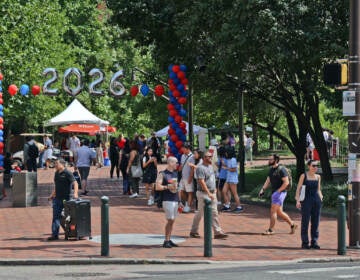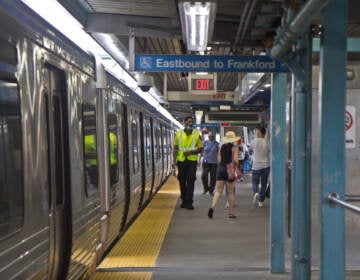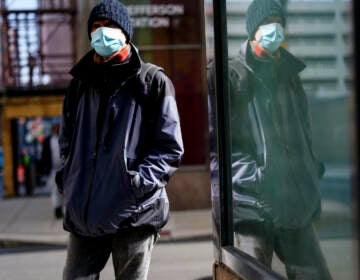Inequality made the perfect storm for a pandemic. North Philly is fighting back.
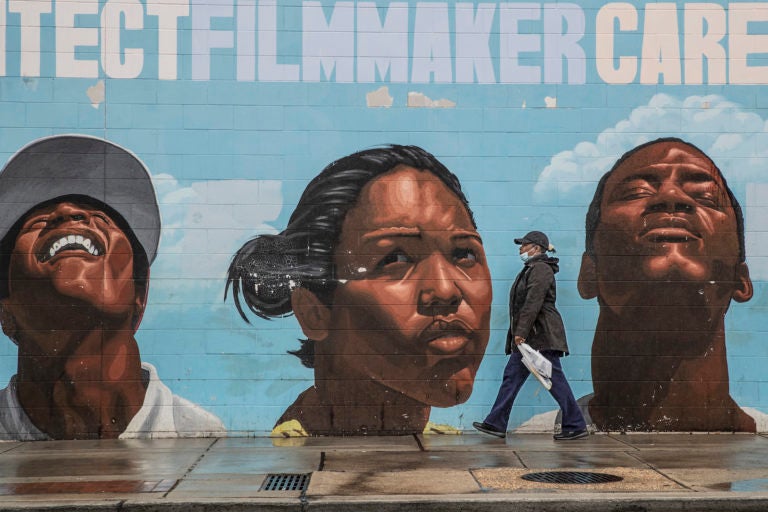
A woman wearing a surgical mask makes her way past a mural on the west side of the Save-A-Lot store at 22nd and Lehigh. (Michael Bryant/The Philadelphia Inquirer via AP)
First, preschool director Michele Ayala and her teachers delivered tablet computers with six months of free internet access to the homes of the 133 preschoolers who attend Trinidad Head Start in Fairhill.
Then Ayala set up an app to send videos to the kids and communicate with parents. When that was a big hit, she launched multiple daily Zoom lessons for her “babies” so they wouldn’t lose any of the learning they’d been absorbing since September.
“We get videos and messages and pictures from our kiddos saying how much they miss us and are sad and they want to go back to school,” said Ayala, whose center is one of four operated by the community development organization Asociación Puertorriqueños en Marcha.
“We write them back, ‘This is just temporary. It’s for us to be safe. This is what is needed right now so when everything is normal, everything is safe for you to go back to school. We’ve got to practice being safe. We’ve got to make the right choices,’” Ayala said.
Ayala and her staff aren’t alone in dedicating long hours and trying new methods to help the city and its vulnerable residents weather the coronavirus lockdown.
Teachers, health care workers, elected officials, grocery store operators, delivery drivers, community organizers and many volunteers have worked overtime for weeks to encourage everyone to comply with Mayor Jim Kenney’s stay-at-home order — and make it feasible for them to do so.
Figures released by the city underline the importance of staying at home, especially in areas like Trinidad’s Fairhill community, where higher rates of chronic health problems, layered with deep social inequities, present the perfect storm for a pandemic.
While the scarcity of testing masks the true number of infected people, a city map counting positive tests for coronavirus in each ZIP code shows a high rate in the school’s 19133 district. Nearly 37% of the 247 people tested in the zip tested positive for COVID-19 infection as of April 9.
Measured by income, the North Philadelphia neighborhood ranks as the city’s poorest, with many residents who do not have access to health care or stable housing, other factors that increase vulnerability to the disease. About half the population is Latinx and a large number do not speak English as a first language.
The virus may be spreading more in those areas because the residents can’t afford to stay at home from work or haven’t absorbed the message about sheltering in place, because of language barriers or because they don’t know anyone who has gotten sick and have not internalized the risks, public health experts say.
“I’m very, very frustrated,” Councilmember Maria Quiñones-Sánchez said.
The councilmember said she heard from doctors at Temple University Hospital that they were seeing a high number of positive tests among Latinx residents, even as her constituents were reporting egregious cases of people gathering outdoors in large groups.
On the last Thursday of March, mild weather drew dozens of people to Waterloo Playground in the West Kensington-Fairhill area, Quiñones-Sánchez said. “They cut one of the gates and there were like 50 kids playing in there, kids and adults. The neighbors were all sending me clips from their cameras, texting me, inboxing me.”

The councilmember said she has been inundated with messages on every imaginable app and social media platform since the coronavirus crisis reached Philadelphia. Many of the calls and messages come from Kensington, where drug users and dealers still cluster on street corners, ignoring the police who periodically drive by with bullhorns, telling them to disperse.
“The residents who live there are like, ‘I can’t go outside. All these people can be contaminated.’ What’s already a bad situation becomes untenable,” Quiñones-Sánchez said. “You can imagine the frustrated calls that I’ve gotten.”
Targeting vulnerable neighborhoods
The need to comply with the city’s orders is particularly urgent in areas where widespread chronic health problems make residents more vulnerable to severe COVID-19 symptoms. In Hunting Park-Fairhill, 23% of residents are in poor physical health compared to 14% citywide, according to a 2019 report by the city’s Department of Public Health.
Nearby Upper Kensington had the bottom ranking for health outcomes in the report, with similar figures to Fairhill for several health conditions.
Philadelphia Health Commissioner Thomas Farley has said the city is not using the ZIP code data to target public health outreach since the virus is present in all areas and services are being delivered citywide.
“This virus does not discriminate,” Farley said during a recent news conference. “The virus is in every neighborhood. It’s in every population. Everyone needs to take our recommendations seriously to avoid getting the infection or passing on the infection.”
But in recent days the city has released data showing that African Americans are being disproportionately impacted by COVID-19. Thirty-eight percent of coronavirus deaths in the city were people who identified as African American while 24% percent were white. The city does not know the racial identity of 36%.
About 44% of the city’s population is Black and 34% non-Hispanic white.
Councilmember Cindy Bass, whose district encompasses majority-Black areas with high rates of people testing positive, described the situation as the tragic outgrowth of longstanding inequalities.
She said poverty and a lack of access to health care, a feeling of distance from the pandemic and longstanding cultural practices may be leading people to ignore the stay-at-home order and risk infection.
“In the African American community we have been known to go to work when we’re sick, we’ve been known to go to work when there’s a tragedy. Like, ‘I don’t have time to worry about coronavirus. I’ve got to worry about keeping the lights on. I’ve got to worry about keeping a roof over my head,’” Bass said. “Coronavirus seems far away, very distant, like, ‘I’ll worry about that when it gets here.’ And we just can’t do that.”
She wondered why the ZIP code data wasn’t playing a bigger role in shaping the city’s strategy for containing the pandemic.
“Why wouldn’t we target an area that has a lot of people who are being affected at a higher rate than other areas throughout the city?” Bass said. “What’s the use of data if you’re not using it to make decisions and to move resources?”
Tailoring the message
One strategy to encourage people to stay at home and practice social distancing is to have charismatic, beloved public figures put out the message in a way that resonates with residents, said Carolyn Cannuscio, a social epidemiologist at the University of Pennsylvania. She cited the example of Chicago Mayor Lori Lightfoot, who made a funny video of herself doing various activities at home and internet memes showing her looming over the city, blocking entrances to parks and telling people to stay home.
Just a friendly reminder from your Auntie to stay home. #StayHomeSaveLives pic.twitter.com/RpX4tgRx2i
— Mayor Lightfoot #StayHomeSaveLives (@chicagosmayor) April 10, 2020
That’s the kind of creative approach City Council could take using a $400,000 appropriation for social distancing messaging approved last week as part of an $85.4 million emergency spending bill.
Quiñones-Sánchez and others said messages need to be expressed in everyday terms that people understand, rather than vague, technical terms like “flattening the curve.”
The councilmember said she envisions robocalls targeted to senior citizens or other vulnerable residents and printed materials like postcard mailers in multiple languages. Others at City Hall have begun experimenting with memes.
Remember when @Beyonce said “I sneezed on the beat, and the beat got sicker?”
A reminder that your germs work the same way. Stay home if you’re sick! #DoingMyPartPHL pic.twitter.com/LUONVIrhJf
— Philadelphia Public Health (@PHLPublicHealth) April 8, 2020
On a conference call organized by Temple University’s Center for Urban Bioethics, an African American community leader from Nicetown urged officials to tailor their messaging to young people, Quiñones-Sánchez said.
“She was like, ‘With all due respect, when you say social distancing, I’m not sure my community gets this. We need to talk about physically staying away from each other.’ Social distancing may be a little too fancy and not getting to the point with some folks,” the councilmember said.
Above and beyond the messaging challenges, there are cognitive biases to battle in all parts of the city.
Social scientists call one type of misperception of risk the “availability heuristic,” Cannuscio said.“If people don’t have an example from their own lives that’s accessible to them of, for example, someone who’s sick with COVID-19, it feels like such an abstract and remote threat that it’s hard to activate the protective mechanisms that would really get people to engage in social distancing,” she said.
Another phenomenon at work is “optimism bias,” where people underestimate risk or think they’ll fare better in a difficult situation than others, Cannuscio said. People are also bad at estimating physical distances, and may think they’re six feet apart when they’re actually closer, she said.
Cannuscio said she’s looked out the windows of her home next to Taney Park, on the east bank of the Schuylkill River, and been upset to see her neighbors and others picnicking despite the city’s social distancing order. It’s vital to remind everyone about the importance of staying at home. But at the same time, she said, there’s also a place for compassion for people fulfilling an “intense need to connect” during an extremely stressful time.
“We’re asking people to change so many behaviors in such a short period of time,” she said.
Cannuscio said it’s important to engineer environments in ways that establish clear social norms and make it easier for people to comply. At her local farmer’s market, Cannuscio annoyed a neighbor by suggesting they stagger their visits into a vendor’s crowded tent, but by the following week the market had set up a handwashing station and drawn lines on the ground six feet apart to encourage social distancing without conflict, she said.
Likewise, people need to have the ability to follow the rules, said Dr. Kathleen Reeves, the director of Temple’s Center for Urban Bioethics.
Children need educational opportunities or other activities they can do at home, like those being provided by Ayala and her staff at Trinidad preschool. Elderly people may need flip phones to maintain social contacts if they don’t know how to use computers, and many people need to get nutrition without going out, Reeves said.
After participants on the center’s conference call expressed concerns about infection rates among the Latinx community, the group arranged to print 10,000 flyers about social distancing in Spanish and English. Cousins Supermarket inserted the flyers into customers’ grocery bags and Asociación Puertorriqueños en Marcha posted them in the windows of corner stores.
Some North Philadelphia communities are understandably wary about public health information they hear. They are more likely to trust information received through community partners who they know well, such as APM, Nicetown CDC and local churches, Reeves said.
Reeves said the center is coordinating with community organizations to deliver 300 bags of groceries weekly, especially to households with senior citizens and children. Temple is funding the deliveries with help from donors, she said. Separately, Cousins Supermarket donated and delivered groceries to 60 seniors in coordination with APM.
“If you have folks who are food-insecure, and you’re telling everyone to stay home, but they have no food, well, that’s not a reasonable thing to ask,” Reeves said. “Trying to help people have the tools they need to enact what we’re asking them to do is also very important.”
WHYY is your source for fact-based, in-depth journalism and information. As a nonprofit organization, we rely on financial support from readers like you. Please give today.



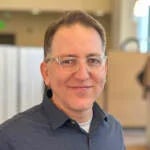
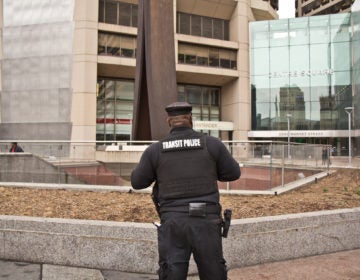


![CoronavirusPandemic_1024x512[1]](https://whyy.org/wp-content/uploads/2020/03/CoronavirusPandemic_1024x5121-300x150.jpg)
